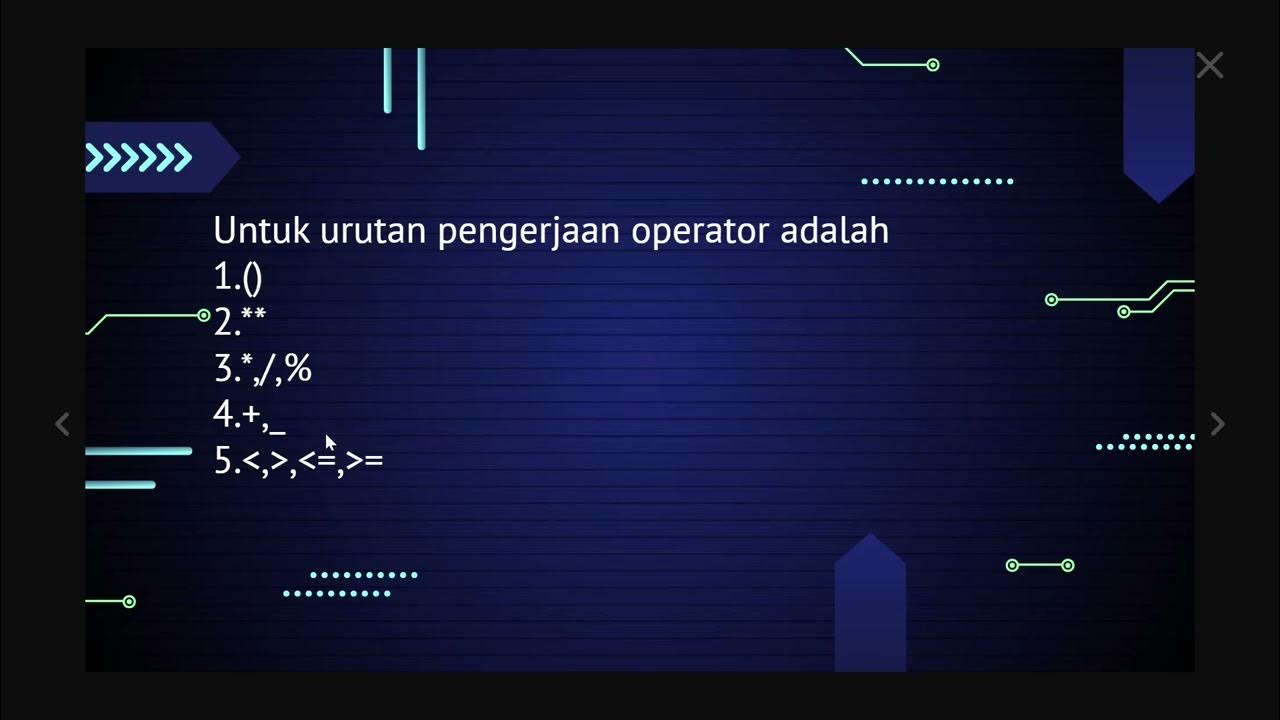43. OCR A Level (H046-H446) SLR8 - 1.2 Introduction to programming part 4 mathematical operators
Summary
TLDRThis video, part of a programming series, delves into the essentials of boolean, arithmetic, and comparison operators. It explains the role of the Arithmetic Logic Unit (ALU) in performing operations and how these are supported by operators in programming languages. The tutorial covers arithmetic operators like addition, subtraction, multiplication, division, modulus, and exponentiation. It also discusses comparison operators for equality, inequality, and relational comparisons. Boolean operators, including NOT, AND, and OR, are introduced with examples of their use in conditional statements. The video concludes with a practical demonstration of these operators in Python, emphasizing the importance of understanding these concepts across different programming languages.
Takeaways
- 🧮 The Arithmetic Logic Unit (ALU) performs arithmetic operations, logical comparisons, and binary shifts, which are supported by operators in programming languages.
- ➕ Arithmetic operators include addition (+), subtraction (-), multiplication (*), division (/), exponentiation (**), modulus (%), and integer division (div).
- 🔄 Modulus (%) returns the remainder of a division, while integer division (div) gives the whole number result of division.
- ✅ Comparison operators are used to compare values and include equality (==), inequality (!=), less than (<), less than or equal to (<=), greater than (>), and greater than or equal to (>=).
- 🔄 Boolean operators include NOT (!), AND (&&), and OR (||), which are used to create boolean expressions that evaluate to true or false.
- 🔄 The NOT operator reverses a boolean value, while AND requires all conditions to be true, and OR requires at least one condition to be true.
- 🔄 Boolean expressions are used in control structures like if statements, while loops, and do-until loops to determine the flow of the program.
- 💻 Programming languages may differ in their syntax for operators, but the underlying concepts remain the same across languages like Python, Visual Basic, C#, Java, etc.
- 📚 Appendix 5d in the A-Level specification provides a guide to pseudocode format, which is useful for understanding exam questions even if you're not familiar with a specific programming language's syntax.
- 📘 For exam preparation, it's beneficial to download the specification and familiarize yourself with the pseudocode format, as well as to use study guides for additional support.
Q & A
What are the main functions of an Arithmetic Logic Unit (ALU)?
-The ALU performs arithmetic operations, logical comparisons, and binary shifts.
What are the common arithmetic operators used in programming?
-Common arithmetic operators include addition (+), subtraction (-), multiplication (*), division (/), exponentiation (**), modulus (%), and integer division (div).
What is the difference between modulus and integer division?
-Modulus (%) returns the remainder of a division, while integer division (div) returns the whole number result of a division.
How is the equals operator represented in most programming languages?
-In most programming languages, the equals operator is represented by a double equals sign (==) to distinguish it from the assignment operator (=).
What are the comparison operators used to check if one value is greater than another?
-The greater than (>) and greater than or equal to (>=) operators are used to check if one value is greater than or equal to another.
What is the purpose of the boolean operator 'not'?
-The 'not' boolean operator is used to reverse the truth value of a condition, effectively negating it.
How does the 'and' boolean operator work in programming?
-The 'and' boolean operator requires both conditions on its left and right to be true for the overall expression to evaluate to true.
What is the role of the 'or' boolean operator in programming?
-The 'or' boolean operator will result in a true expression if at least one of the conditions on its left or right is true.
How can boolean expressions be used in control structures like loops?
-Boolean expressions are used in control structures such as if statements, while loops, and do-until loops to determine whether the code within the structure should execute.
Why is it important to be familiar with the symbols or terms used by OCR in exams?
-Being familiar with the symbols or terms used by OCR in exams ensures that you can understand the questions and provide answers in a format that can be reasonably inferred by a competent programmer, even if you are not using the exact syntax shown in the exam papers.
What is the significance of Appendix 5D in the programming language specification for exams?
-Appendix 5D in the programming language specification provides a guide to the format of pseudocode that may appear in exams, helping learners familiarize themselves with the expected format without needing to memorize a specific syntax.
Outlines

هذا القسم متوفر فقط للمشتركين. يرجى الترقية للوصول إلى هذه الميزة.
قم بالترقية الآنMindmap

هذا القسم متوفر فقط للمشتركين. يرجى الترقية للوصول إلى هذه الميزة.
قم بالترقية الآنKeywords

هذا القسم متوفر فقط للمشتركين. يرجى الترقية للوصول إلى هذه الميزة.
قم بالترقية الآنHighlights

هذا القسم متوفر فقط للمشتركين. يرجى الترقية للوصول إلى هذه الميزة.
قم بالترقية الآنTranscripts

هذا القسم متوفر فقط للمشتركين. يرجى الترقية للوصول إلى هذه الميزة.
قم بالترقية الآنتصفح المزيد من مقاطع الفيديو ذات الصلة
5.0 / 5 (0 votes)






